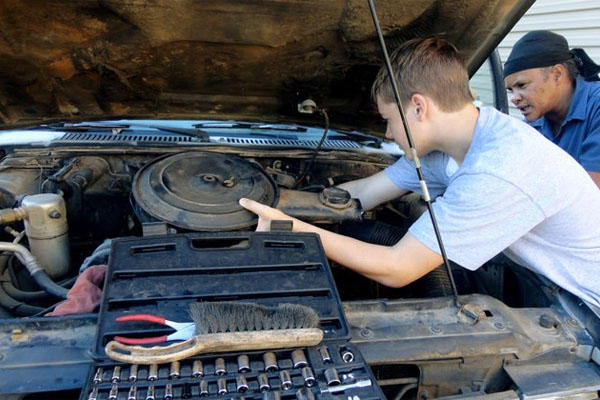Overcoming Overheating
The first sign of overheating is either when the needle on the temperature gauge pushes its way into the ominous red zone or the "Check Engine" or "Temperature" malfunction indicator light on the dashboard casts a sinister glow. Left alone, the liquid in the radiator eventually boils over and steam rolls out from under the hood.
Caution: If you ignore the problem, your vehicle eventually loses power, your engine grinds to a halt, and you end up with a giant repair bill. If you take action at the first indication of a problem, you probably can avoid this doomsday scenario. Even if you end up needing major repairs, at least you'll know that youexplored all the cheaper options first.
Addressing Occasional Overheating
Tip: Although overheating isn't the problem it once was — there was a time when most every vehicle overheated occasionally — it can still happen. Often the cause of the problem is nothing more than being stuck in stop-and-go traffic on a hot day.
Dealing With a Chronic Hothead
If your vehicle overheats often and constantly loses coolant, the problem may be caused by one or more leaks in your cooling system. If your vehicle overheats in normal weather and traffic, you may need to add liquid to the system, replace the thermostat, adjust or replace the accessory belt, or check the water pump.
The first thing to check if your vehicle overheats often is the pressure cap. Sometimes the gasket on the cap deteriorates and lets pressure escape, which causes the cooling system to malfunction. Most service stations can test your cap for you and tell you whether it's in good condition.
True Story: When I bought Tweety Bird, my first car, she sang when I shut off the engine! Her mysterious behavior was eliminated by a new pressure cap. Although I paid for some unnecessary (and unsuccessful) repairs before it occurred to me to ask the shop to test the cap, I was luckier than someone I met who paid big bucks for radiator rebuilding and a new water pump before discovering that all he needed was a cap that cost less than $10! Lesson learned: Professionals sometimes try the more profitable solutions first. Do-it-yourselfers try the cheapest solution first.
Caution: If your vehicle is old and the cooling system isn't leaking, be sure the shop just pressure tests the cap. Pressure testing the entire system can sometimes cause leaks by blowing out any stuff that's plugging them up!
Identifying Other Causes of Overheating
Tip: Some overheating problems aren't related to the cooling system at all. Other circumstances that can cause a vehicle to overheat include lack of oil, a blown head gasket, and transmission problems. If the cooling system seems to be in good order after you check it and do the maintenance work, investigate these possibilities:
- Late timing: If your ignition system is malfunctioning, late timing may be causing your vehicle to overheat because the spark plugs are firing the fuel/air mixture after the piston moves back down from the top of its stroke. When the spark plugs fire too late to allow all the fuel to burn properly, more heat burdens your cooling system. Late timing alone doesn't cause an engine to overheat by more than a few degrees, but when coupled with other problems, it can bring the engine temperature to a critical point. The remedy is simple: Have a service facility place your vehicle on an electronic diagnostic machine to check your timing and adjust it if necessary.
- Plugged radiator: Some radiators get so plugged up with rust, sediment, or small insects that even cleaning and flushing them doesn't get all the junk out. Because plugged passages cut down on the system's liquid circulation, the system can't cool efficiently. The remedy is to have a radiator specialist remove and inspect the radiator. If you're lucky, just steam-cleaning the radiator does the job; if you're not, the solution may be more expensive. Keep your fingers crossed. . . .
- Slipping accessory belt: On many modern vehicles, the accessory belt is hidden by a plastic shield or dust cover that may be difficult to remove. However, if you can see and reach the accessory belt that drives the water pump, check to be sure that there's no more than about 1⁄2 inch of give. If the belt is looser than that, it may not be driving the pump properly, and that can impair circulation and overheat the cooling system. If the belt seems loose or very frayed, you can try to replace it. If you can't do the job, have a professional deal with it.
- Collapsing bottom radiator hose: Occasionally, a bottom radiator hose begins to collapse under the vacuum that the water pump creates, and the impaired circulation causes overheating.
- Low oil level: If you still can't find the cause of overheating, check your oil dipstick. A vehicle that's low on oil tends to overheat because the oil removes from 75 to 80 percent of the "waste heat" in your engine (in addition to doing its other job of cushioning the moving engine parts).
If you're one quart low in oil and your vehicle holds five quarts, the oil will carry away 20 percent less heat than it should.
From Auto Repair for Dummies, copyright © 2009 by Wiley Publishing, Inc., Indianapolis, Indiana. Used by arrangement with John Wiley & Sons, Inc.










